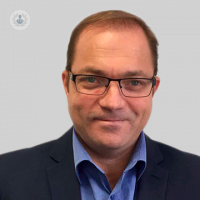Lumbar spinal stenosis: diagnosis and treatment
Escrito por:Degenerative changes of the spine occur in up to 95% of people by the age of 50. So it’s no surprise that spinal stenosis is most often found in older adults who are aged 60 or over.

We spoke with leading spinal surgeon Mr Shaun Ridgeway to find out how stenosis of the spine occurs, how It can be diagnosed and how it can be treated. We also found out the success rate of surgical decompression, a procedure that is sometimes used to treat this condition.
What is lumbar spinal stenosis?
Natural aging of the spine that causes wear and tear that causes natural narrowing of the spine, and nerve routes. Side, lateral recess or where the nerves come out.
It’s not a slipped disk, stenosis is a chronic buildup so doesn’t tend to go away, one can have it and not have symptoms. We only treat it if the patient has symptoms from it.
What causes lumbar spinal stenosis?
Thickening of tissue, loss of disc height, loss of fluid, gradual compression of the spine, osteoarthritis, extra bone, gradual narrowing of canal and nerve route compression/ radiological stenosis. Clinical stenosis is where it causes you symptoms.
Can lumbar spinal stenosis cause lower back pain?
Actual symptoms include stenotic, claudication, gradual onset of symptoms, pain, pins and needle, numbness, heaviness and weakness in lower limbs,
When you walk or if you are active, it may trigger symptoms at varying degrees. Symptoms can include claudication distance, in early phases symptoms can be of lower back pain, 1, 2 both all of them, gradually increasing with severity of stenosis to more constant severe symptoms which can occur at rest.
A long time can pass before people present with symptoms. When someone has it, it’s usually because they have symptoms and in 80% of cases they slowly get worse.
How should lumbar spinal stenosis be prevented?
It can’t be prevented. It’s not cancer, it doesn’t affect how long you live but it affects quality of life.
How is lumbar spinal stenosis diagnosed?
We would look at the patients’ medical history, often very little is found during the first consultation. We examine to find out the severity.
We would check for narrowing of arteries, we would look at the patients’ medical history and carry out an MRI scan to exclude sinister causes such as cancer or fracture.
We would carry out an MRI scan to confirm suspicions and examine the symptoms to make sure they’re not peripheral. After, we would show the patient the scans and let them know how they can manage lumbar spine stenosis if the condition is diagnoses.
We would have a look at their natural history, most patients can manage lumbar spine stenosis with physiotherapy or osteopathy and painkillers. If this doesn’t work and they find that their quality of life is still affected, we look at other treatment and interventions.
How should lumbar spinal stenosis be treated?
There are three ways of treating neck stenosis, through:
- Physical therapy
- Epidural injections
- Surgical decompression.
Epidural is a steroid substance that can be used for the nerves, around narrowing’s of the spine, it tends to relieve pain but doesn’t take the pain away. Stenosis injections very rarely provide long term benefit as their effects do not last very long. It has a low success rate. Surgical decompression has an 80-90% success rate.
For surgery without complications risks, benefits and what happens during the procedure is explained to the patient before they decide whether or not to undergo surgery.
This is a good operation to relieve leg pain that often reduces a patient’s ability to walk properly. Most patients will have a significant improvement in walking, leg symptoms, 85% after five years. Surgical decompression has one of the best success rates in orthopaedics in general.
There’s keyhole surgery, mini open, or open. The actual technique will only decrease hospital stay and post-operative pain, but after 3 months the results will all be the same for all patients.
If you’re currently suffering from back pain or believe you may have spinal stenosis, we recommend booking an appointment with a leading spinal surgeon such as Mr Shaun Ridgeway. Visit his Top Doctors profile today for more information.



